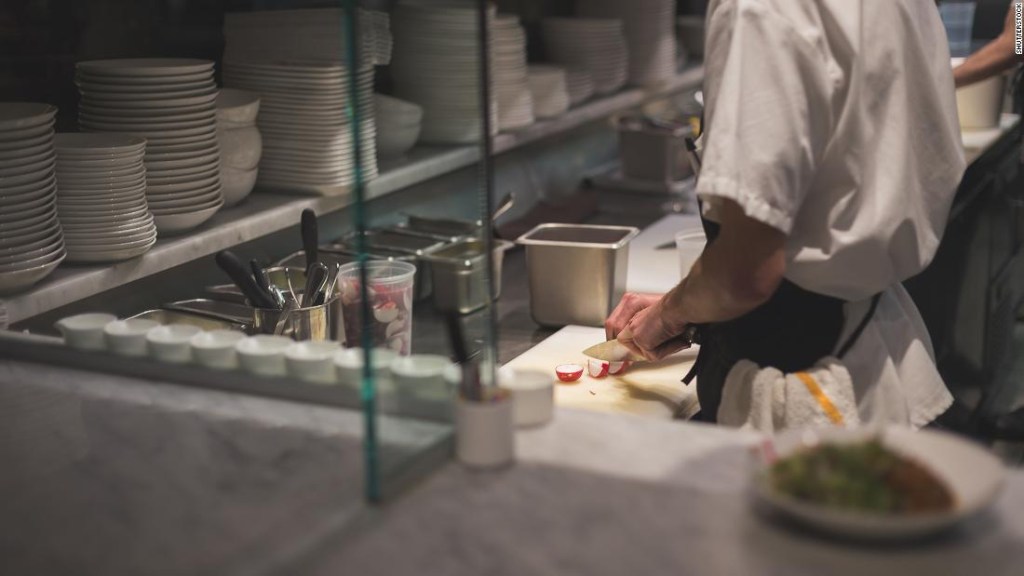Restaurants fear inflation will force them to close 1:06
New York (CNN Business) -
Eating out can seem a little different these days.
Maybe you wait longer for a table, even if the restaurant doesn't seem crowded.
Or maybe the service is slower, and your server seems eager.
This is because restaurants across the United States are understaffed, and already stressful jobs have become even more difficult.
Workers interviewed by CNN Business said they struggle in an environment of understaffing.
Waiters take on other duties as overburdened back-room employees quit, sometimes watching their tips dwindle as they struggle to meet new responsibilities.
Often times, fed up, quit in the middle of their shifts.
Some workers claim that their colleagues have resigned in the middle of the shift.
They are in this situation because during the pandemic many workers were laid off, as security measures forced some restaurants to close restaurants completely.
In the end, when restaurants started hiring, they found themselves with a smaller pool of potential employees.
Some moved, others found new jobs in other sectors.
Some continue to stay home to care for their children or others who depend on it.
Others, fed up with what are often low wages for hard work, vowed never to return.
Millions of jobs and candidate shortages.
Welcome to the new economy
In an attempt to attract those who are still interested in restaurant jobs, some employers have raised wages or increased benefits.
Extras can help, but they can't fix the fact that when restaurants are understaffed, those who come in have to take on a lot of extra work.
Some plan to hold out, while others wonder if the time has come to leave the industry.
advertising
People who quit in the middle of their shifts
Joshuah Morton, 36, has worked as a waiter at a Cheddar's Scratch Kitchen in Phoenix, Arizona, for about four years.
Morton is diabetic and has a four-year-old son with an immunodeficiency.
When the pandemic hit, he stopped working, fearing for his health.
But in October he was ready to go back to work.
"Sitting at home all the time was getting depressing," he said.
And, of course, the money was an incentive.
Around this time, Morton realized that the restaurant was having a hard time attracting employees again.
Once he started recruiting new people, many of them gave in to the pressure.
"People leave mid-shifts," Morton said.
"The hostesses who wait for the tables, the dishwashers, the waiters ... they leave," he said.
Morton understands why people can quit.
After waiting to be located, customers arrive at their tables "already angry, already wanting to complain," he said.
A few weeks ago, an employee began to cry because a customer was very mean to her.
To top it off, there are more takeout orders than before.
"It's almost as if we run twice the restaurant, comparatively, with half the staff."
Darden, the owner of Cheddar's, did not respond to a request for comment.
Morton has also considered resigning.
"I don't think there is any employee who has not been tempted to quit," he said.
"Especially now."
But right now you get what you need from Cheddar's.
Darden is "by far one of the best" employers he has ever had, Morton said.
Darden recently raised employee salaries and offers health benefits, which are especially important given Morton's medical expenses, who is also studying biochemistry, so flexible hours are important to him.
"That is the great reason why I am here," he said.
"It's hard to find a job where you can work 30 hours a week and still earn $ 35,000 a year."
That salary, along with the rent he charges from his brother, is enough to support himself, his wife and his son.
"I don't know what else I would do."
Serve, attend and carry the food
Karen McLaughlin, 58, has been a waitress at Provino's, an Italian restaurant in Chattanooga, Tennessee, for about two years.
Working conditions have been especially tough lately.
Some people are hired and never show up, he says.
Others arrive and resign after a week.
For McLaughlin, that means having to work multiple positions per shift.
This is how the recovery of US restaurants progresses 1:31
Some days "there are no helpers, so we have to take the orders, serve the dishes ourselves and take care of all the tables," he explains.
"Waiters have been called in to work the food line, to prepare the salads, to wash the dishes. We arrive and we just have to fill in the gaps," he explained.
Sometimes the employees that are there are not enough.
"There was a day when half the kitchen didn't show up," he said.
"So we had to open an hour later."
The added responsibility means that servers spend less time with customers and therefore earn less in tips.
"If you have other things to do ... then you earn less," McLaughlin said.
John Miles, Provino's general manager for about 36 years, said that when employees take up other duties, their pay is adjusted so that they earn the same as normal.
Miles described the current environment as very difficult.
"We have never suffered from the problems that we have now, like not having enough employees," he said.
Of the current employees, "I asked everyone to do their best," he said.
"And some of them have gone further."
McLaughlin has been working in restaurants for about eight years;
he calls it his "early retirement plan," after working in the telecommunications industry for decades.
The flexibility of your job in a restaurant allows you to spend more time with your grandson.
In general, "I really enjoy what I do," he says.
"Except this year."
Still, he hopes things will change over time and plans to continue working in the hospitality industry.
But understand that for younger, less experienced employees, the job is unappealing.
"It's harder work than it used to be," he says.
"So they go into something [where] they can't see that it's going to get better at some point."
Clients who don't understand
Customers at the Richmond, Virginia Asian fusion restaurant where 18-year-old Kat Combs works are usually friendly, she says.
But since the reopening, some have been lousy.
"One of the first nights of the reopening, a guy came up to the bar and yelled at the manager. He told him that he had to hire more staff, as if she could solve the problem at that moment," he explains.
Why is there a shortage of employees in Florida?
4:02
Some customers get frustrated when they have to wait for a table, even though many of them are unoccupied.
They don't understand that the restaurant doesn't have enough staff to serve or cook their food, Combs said.
"I try to explain it to them and most of the time they understand," Combs added.
But sometimes, he said, they don't care what she has to say.
Combs will quit his job at the end of the summer, when he enters his sophomore year of college.
There, you will likely look for a job on campus.
Ingrid Moody, 56, has been working since November at a steakhouse in Riverview, Florida.
He has also found that customers are more difficult.
Today, some clients feel "entitled," he says.
"We have less staff and equipment in the kitchen and people don't seem to care," he said.
"They are very demanding. And they retaliate with the tips."
Moody considers quitting his job.
"If a better opportunity presented itself in a restaurant right now, I would probably take it," he said.
employeesRestaurants








